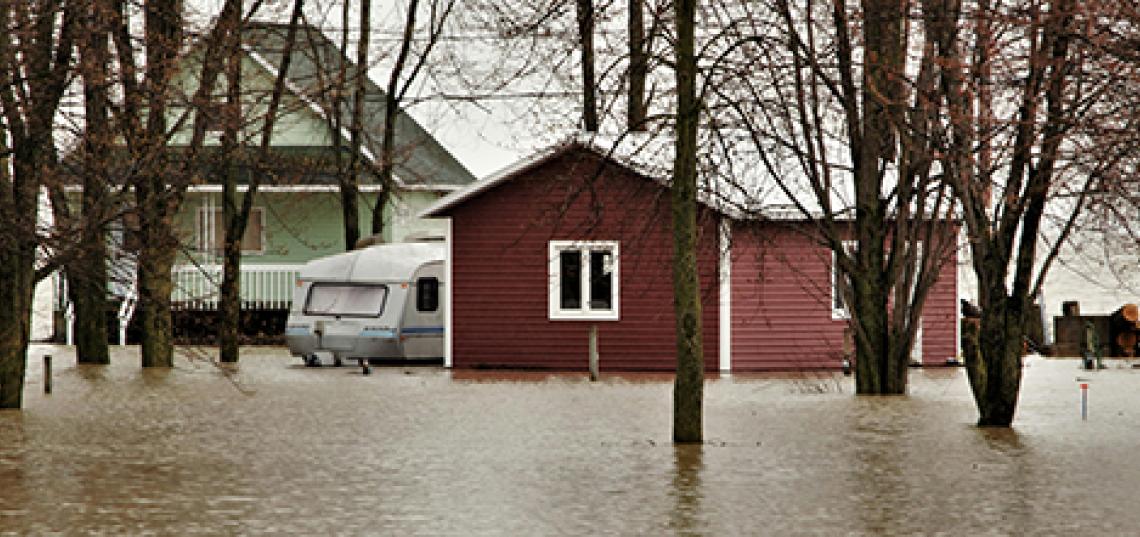
News stories that include vivid photos of episodic climate change-related flooding (specifically flooded houses) significantly increase the perception among Americans that such flooding is a threat, according to a new Rutgers study.
Conversely, when media outlets and other climate change communicators include images of statistical maps depicting flooding risk, the news coverage has no effect on people’s perceptions of climate change-related flooding as threatening, compared to news stories that don’t include any imagery at all.
However, even graphic photos of flooding do not help decrease polarization between American liberals and conservatives in their perceptions of the risks posed by climate-change related flooding. Liberals have much higher flooding risk perceptions than conservatives, regardless of whether the news they consume includes imagery or not, the research found.
The study also found that when news stories report that Democrats and Republicans are divided in their beliefs about the link between climate change and flooding, these party cues lower the public’s perceptions of flooding as a threat.
The study, “The Influence of Flooding Imagery and Party Cues on Perceived Threat, Collective Efficacy, and Intentions for Political Action to Address Climate Change” by SC&I Professor of Journalism and Media Studies Lauren Feldman and her colleagues P. Sol Hart, Soobin Choi, Annie Li Zhang, and Austin Hegland, all of the University of Michigan, was published in the journal Science Communication.
Their findings have important implications for the practice of climate change journalism, Feldman said. “News about climate change has become increasingly politicized and polarized over the last several decades, and news stories about climate change often emphasize divides and conflicts between political parties over climate policy and other aspects of climate change. Our findings indicate that when journalists emphasize partisan conflict and division in their reporting on climate change, this can undermine public concern about the issue.”
To explain the starting point for the study, Feldman pointed to two recent trends in news coverage of climate change: the use of imagery depicting extreme weather such as flooding and the inclusion of political party cues (i.e., information about where the two U.S. political parties stand on climate change).
“Broadly,” Feldman said, “we were interested in how different types of news images of flooding, along with the presence of party cues in news stories, affects people’s risk perceptions of both flooding and climate change, their collective efficacy beliefs, their intentions to take political action to address climate change, and whether the effects of the imagery might vary depending on an individual’s political ideology.”
Feldman said to conduct the study she and her collaborators conducted an online survey experiment with a national sample of 4,408 U.S. adults recruited from Lucid, an online sample provider. Participants read a news article that varied both the presence and type of flooding imagery and the presence and type of party cues. The researchers compared the effects of two different types of images of flooding: episodic images that focus on a vivid example of flooding (e.g., a photograph of a flooded house) versus thematic images that offer broader context about an issue (e.g., a map of flooding risk based on statistical data).
They also compared the effects of political party cues about the public (i.e., ordinary citizens) versus elites (i.e., members of Congress).
The lack of effects for thematic imagery that uses statistical maps may suggest, Feldman said, “that people have a difficult time interpreting these images; thus, more care may be needed to ensure the effectiveness of this type of imagery in communicating about climate change risks.”
They found that news stories that included political party cues, regardless of whether these cues pertained to the public or political elites, decreased people’s perceptions of flooding as a threat compared to news stories that did not include party cues.
They also found significant effects of imagery and party cues on people’s perceptions of whether flooding is a threat, but not on their perceptions of whether climate change is a threat.
“We suspect that this is because people’s views on climate change are more fixed than their views on flooding, due to the politicization of climate change in the U.S.,” Feldman said. This finding has implications for the practice of climate change journalism and public relations, suggesting that climate advocates and other climate communicators may want to focus on narratives that emphasize the specific threats posed by climate change, such as flooding and public health risks, rather than focusing on climate change in general, Feldman said.
They also explored whether vivid photos of flooding might not only convince the public that climate-change related flooding is threatening, but also whether it might also inspire them to take some kind of political action to mitigate climate change (e.g., contact an elected official, attend a protest, etc.).
Feldman said they did find “indirect effects of the message factors on efficacy and intended political action through effects on flooding risk perceptions. Specifically, episodic imagery increased flooding risk perceptions, and risk perceptions were positively related to collective efficacy beliefs and political action intentions. Thus, exposure to news stories that include episodic imagery indirectly help drive collective efficacy and climate action intentions through effects on flooding risk perceptions. On the other hand, because party cues decreased flooding risk perceptions, party cues had a negative indirect effect on efficacy and action intentions.”
“Despite this,” Feldman added, “it’s still important to keep in mind that the observed effects were small overall, and imagery and party cues only had total effects on flooding risk perceptions, and not on climate risk perceptions, collective efficacy beliefs, and political action intentions. The results thus point to the limits of using message features to shift climate change attitudes and behaviors.”
Learn more about the Journalism and Media Studies Department and major at the Rutgers School of Communication and Information on the website.
Photo: Serge Lavoie for Pexels
